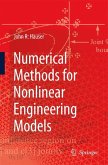In computational mechanics, the first and quite often the most difficult part of a problem is the correct formulation of the problem. This is usually done in terms of differential equations. Once this formulation is accomplished, the translation of the governing differential equations into accurate, stable, and physically realistic difference equations can be a formidable task. By comparison, the numerical evaluation of these difference equations in order to obtain a solution is usually much simpler. The present notes are primarily concerned with the second task, that of deriving accurate, stable, and physically realistic difference equations from the governing differential equations. Procedures for the numerical evaluation of these difference equations are also presented. In later applications, the physical formulation of the problem and the properties of the numerical solution, especially as they are related to the numerical approximations inherent in the solution, are discussed. There are numerous ways to form difference equations from differential equations.








